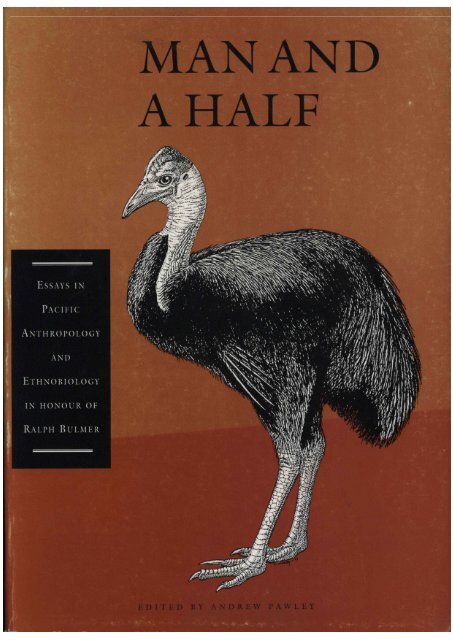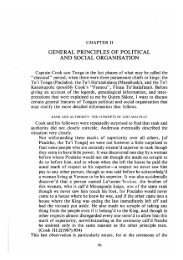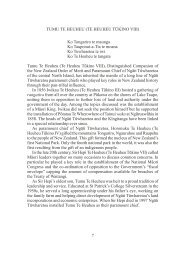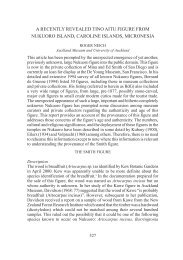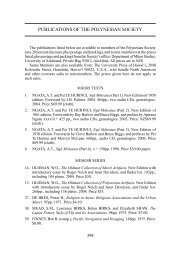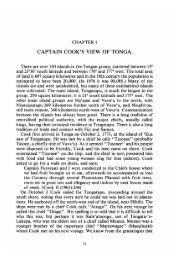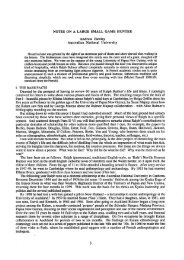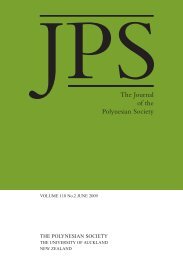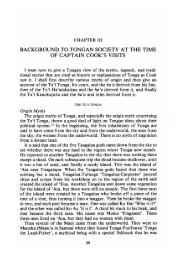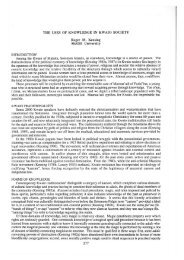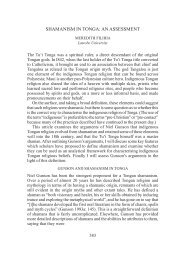MEMOIR No. 48 MAN AND A HALF ESSAYS IN PACIFIC ...
MEMOIR No. 48 MAN AND A HALF ESSAYS IN PACIFIC ...
MEMOIR No. 48 MAN AND A HALF ESSAYS IN PACIFIC ...
Create successful ePaper yourself
Turn your PDF publications into a flip-book with our unique Google optimized e-Paper software.
<strong>MEMOIR</strong> <strong>No</strong>. <strong>48</strong><br />
<strong>MAN</strong> <strong>AND</strong> A <strong>HALF</strong><br />
<strong>ESSAYS</strong> <strong>IN</strong> <strong>PACIFIC</strong> ANTHROPOLOGY<br />
<strong>AND</strong> ETHNOBIOLOGY<br />
<strong>IN</strong> HONOUR OF RALPH BULMER<br />
edited by<br />
<strong>AND</strong>REW PAWLEY<br />
THE POLYNESIAN SOCIETY<br />
Auckland<br />
1 9 9 1
First published 1991<br />
The Polynesian Society (Inc. )<br />
Anthropology Department<br />
University of Auckland<br />
Private Bag 92019<br />
Auckland<br />
New Zealand<br />
Printed by the Australian National University Printing Service, Canberra, A. C. T.<br />
Bound by F & M Perfect Bookbinding, Queanbeyan, N. S. W.<br />
Cover design by A. N. U. Graphic Design<br />
© The Polynesian Society (Inc. ) 1991<br />
All rights reserved. <strong>No</strong> part of this publication may be reproduced,<br />
stored in a retrieval system or transmitted in any form or by any<br />
means, electronic, photocopying, recording or otherwise,<br />
without the prior permission of the publishers.<br />
ISBN 0-908940-01-7
CONTENTS<br />
Editorial note page vii<br />
PART I: <strong>MEMOIR</strong>S<br />
Andrew PAWLEY <strong>No</strong>tes on a Large Small Game Hunter 3-20<br />
Ellaine MABBUTT Hans Breitmann Gife a Barty... 21-23<br />
Helga M. GRIFF<strong>IN</strong> ‘Big-man’, Neighbour, Teacher, Friend: a Personal<br />
Memoir of Ralph Bulmer at Waigani, 1968-72 23-29<br />
Ian Saem MAJNEP What Is this Man Up To? A Kalam View of Ralph Bulmer 29-36<br />
George E. MARCUS <strong>No</strong>tes and Quotes Concerning the Further Collaboration of Ian<br />
Saem Majnep and Ralph Bulmer: Saem Becomes a Writer 37-45<br />
Alice BULMER Ralph Bulmer - a Bibliography 45-54<br />
PART II: ETHNOBIOLOGY, SE<strong>MAN</strong>TICS <strong>AND</strong> TAXONOMY<br />
Brent BERL<strong>IN</strong> The Chicken and the Egg-head Revisited: Further Evidence for<br />
the Intellectualist Bases of Ethnobiological Classification 57-66<br />
Bruce BIGGS A Linguist Revisits the New Zealand Bush 67-72<br />
Cecil H. BROWN On the Botanical Life-form ‘Tree” 72-78<br />
Ross CLARK Fingota/Fangota: Shellfish and Fishing in Polynesia 78-83<br />
Jared M. DIAMOND Interview Techniques in Ethnobiology 83-86<br />
Peter DWYER and Hunting and Harvesting: the Pursuit of Animals by Kubo<br />
Monica MENNEGAL of Papua New Guinea 86-95<br />
Roy ELLEN Grass, Grerb or Weed? A Bulmerian Meditation on the<br />
Category monote in Nuaulu Plant Classification 95-101<br />
Claudine FRIEDBERG Operative Aspects of Folk Classification 102-109<br />
Terence E. HAYS Interest, Use, and Interest in Uses in Folk Biology 109-114<br />
K.J. HOLLY<strong>MAN</strong> What’s in a <strong>No</strong>mial? Folk Classification in New Caledonia 114-118<br />
Robin HOOPER Denizens of the Deep: the Semantic History of<br />
Proto-Polynesian *palu 119-127<br />
iii
iv Contents<br />
Alan HOWARD Animals as Metaphors in Rotuman Sayings<br />
andJanRENSEL 127-137<br />
Eugene S. HUNN Sahaptin Bird Classification 137-147<br />
Julie PARK Why Is Wine <strong>No</strong>t Booze? 147-151<br />
Paul SILLITOE Worms that Bite and Other Aspects of Wola Soil Lore 152-163<br />
Michael J. TYLER Biological <strong>No</strong>menclature, Classification and the<br />
Ethnozoological Specieme 164-167<br />
Alanieta WAQANIU Ethno-ichthyology in the Upper Wainimala Valley,<br />
and Garth ROGERS Viti Levu 167-174<br />
PART III: SOCIAL <strong>AND</strong> SYMBOLIC SYSTEMS<br />
Georgeda BUCHB<strong>IN</strong>DER When All Else Fails: Suicide among Maring Women 177-181<br />
Ann CHO WN<strong>IN</strong>G Pigs, Dogs and Children in Molima 182-187<br />
Peter CROWE There’s More than One Way to Be a 187-193<br />
Mary DOUGLAS Ralph Bulmer among the Master Detectives: the Proximity<br />
Principle 193-198<br />
Thomas M. ERNST Empirical Attitudes among the Onabasulu 199-207<br />
Steven FELD Cockatoo, Hombill, Kingfisher 207-213<br />
Robin FOX A Darwinist Manifesto 213-218<br />
Michael GODDARD The Birdman of Kiripia: Posthumous Revenge in a<br />
Papua New Guinea Highland Community 218 -222<br />
Murray GROVES Fishermen of Manumanu: in Defence of ‘Empiricist’<br />
Ethnography 222-233<br />
Chris HEALEY Why Is the Cassowary Sacrificed? 234-241<br />
Christine HELLIWELL Many Voices: Rhetoric and Ethnographic Understanding in a<br />
Borneo Dayak Community 241-2<strong>48</strong><br />
Antony HOOPER and Aspects of Skipjack Fishing: Some Tokelau 4 Words of the Sea’<br />
Judith HUNTS<strong>MAN</strong> 249-256<br />
David HYND<strong>MAN</strong> The Kam Basin Homeland of the Wopkaimin: a Sense of Place 256-265<br />
Graham JACKSON Is Taboo Alive? The Uses and Parameters of Kopon Taboo 265-276<br />
Roger M. KEES<strong>IN</strong>G The Uses of Knowledge in Kwaio Society 277-286<br />
Tomas LUDVIGSON Transactions and Ownership in Central Espiritu Santo, Vanuatu 286-292<br />
Kenneth MADDOCK Atrocities and Culture: Revisiting the Vietnam War 293-298
Contents v<br />
George E.B. MORREN, Jr The Ancestresses of the Miyanmin and Telefolmin: Sacred and<br />
Mundane Definitions of the Fringe in the Upper Sepik 298-305<br />
Jan POUWER The Willed and the Wild: the Kalam Cassowary Revisited 305-316<br />
Inge RIEBE Do We Believe in Witchcraft? 317-326<br />
Eleanor RIMOLDI Buka Marriage Ritual and the Power of Tsunono<br />
andMaxRIMOLDI 326-335<br />
Paula G. RUBEL and From Ceremonial Exchange to Capitalist Exchange: How the New<br />
Abraham ROS<strong>MAN</strong> Irelanders Coped with the Establishment of Trading Stations 336-343<br />
Anne SALMOND Tipuna - Ancestors: Aspects of Maori Cognatic Descent 343-356<br />
Eric SCHWIMMER The Ceremonial Self 356-363<br />
Marilyn STRATHERN Naming People 364-369<br />
John D. WAIKO Literary Art Forms among the Binandere 369-375<br />
James B. WATSON Group and Ethnic Stereotypy: Topical Premises on a Universal<br />
Ground 375-379<br />
Michael W. YOUNG The Sea Eagle and Other Heroic Birds of Nidula Mythology 380-389<br />
PART IV: L<strong>IN</strong>GUISTIC <strong>AND</strong> TEXTUAL ANALYSIS<br />
Bernard COMRIE On Haruai Vowels 393-397<br />
Herbert John DAVIES Marked Pronouns and Verbs for Marked Social Relationships<br />
in a Chadic and a Papuan Language 397-405<br />
Raymond FIRTH Tikopia Songs of the Sea<br />
and Rosemary FIRTH 405-412<br />
John KIAS We Threw away our Bows and Axes<br />
and Lyle SCHOLZ 412-420<br />
John LYNCH Pigs and Dogs in Island Melanesia 421-432<br />
Andrew PAWLEY Saying Things in Kalam: Reflections on Language and<br />
Translation 432-444<br />
Wendy POND Austronesian Classification and the Choice of Endeavour 444-450<br />
B ambi B. SCHIEFFEL<strong>IN</strong> Sociolinguistic Dimensions of Kaluli Relationship Terms<br />
and Steven FELD 451-454<br />
PART V: PREHISTORY <strong>AND</strong> ORAL HISTORY<br />
Jim ALLEN Hunting for Wallabies: the Importance of Macropus agilis as a<br />
Traditional Food Resource in the Port Moresby Hinterland 457-461<br />
Wal AMBROSE Manus, Mortars and the Kava Concoction 461-469
vi Contents<br />
Susan BULMER Variation and Change in Stone Tools in the Highlands of<br />
Papua New Guinea: the Witness of Wafielek 470-478<br />
Janet DAVIDSON Bird-man Amulets and Tridacna Shell Discs from Taumako,<br />
and Foss LEACH Solomon Islands 478-<strong>48</strong>3<br />
JackGOLSON Bulmer Phase II: Early Agriculture in the New Guinea<br />
Highlands <strong>48</strong>4-491<br />
R.C. GREEN Near and Remote Oceania - Disestablishing “Melanesia” in<br />
Culture History 491-502<br />
Geoffrey IRW<strong>IN</strong> Themes in the Prehistory of Coastal Papua and the Massim 503-510<br />
Mary-Jane MOUNTA<strong>IN</strong> Bulmer Phase I: Environmental Change and Human Activity<br />
through the Late Pleistocene into the Holocene in the<br />
Highlands of New Guinea: a Scenario 510-520<br />
Nigel ORAM Edai Siabo: an Ethnographic Study of a Papuan Myth 520-535<br />
Marie REAY Oral Prehistory and the Sequence of Events 535-540<br />
Douglas G. SUTTON The Archaeology of Belief: Structuralism in Stratigraphical<br />
Context 540-550<br />
Pamela SWADL<strong>IN</strong>G Garden Boundaries as Indicators of Past Land-use Strategies:<br />
Two Case Studies from Coastal Melanesia 550-557<br />
D.E. YEN Domestication: the Lessons from New Guinea 558-569<br />
PART VI: ANTHROPOLOGY <strong>AND</strong> THE MODERN WORLD<br />
I.H. KAWHARU Sovereignty vs Rangatiratanga: the Treaty of Waitangi 1840 and<br />
the New Zealand Maori Council’s Kaupapa 1983 573-581<br />
Roderic LACEY ‘History Is a Way of Musing upon Ourselves’ 581-585<br />
H.B. LEV<strong>IN</strong>E Participation in the Modem Sector and the Width of Urban<br />
Interethnic Interaction: a Causal Model of Data from<br />
Papua New Guinea 585-589<br />
Cluny MACPHERSON and Some Samoan Observations on Science and Scientists<br />
La’avasa MACPHERSON 589-593<br />
Mervyn MEGGITT The Ambiguities of Advocacy: Fieldwork in the New Guinea<br />
Highlands 593-599<br />
Maev O’COLL<strong>IN</strong>S Applied Anthropology: the Basis for Social Policy and Planning<br />
in Papua New Guinea 599-606<br />
Anton PLOEG Citizenship in Papua New Guinea 606-612<br />
Andrew STRATHERN “Company” in Kopiago 612-615<br />
Ranginui J. WALKER The Genesis and Transformation of the Waitangi Tribunal 615-624
EDITORIAL NOTE<br />
In June 1988, when Ralph Bulmer was already mortally ill, invitations were sent to over 100<br />
friends and colleagues of his, inviting them to contribute to an extraordinary Festschrift. It was<br />
extraordinary because, knowing that Ralph probably did not have long to live, I asked each<br />
person to submit a paper within six weeks and to donate $100 towards publication costs, with the<br />
aim of presenting a modest book to Ralph before the end of the year. Because of this stringent<br />
deadline I did not expect to receive more than a handful of papers.<br />
The response was astonishing. Almost 90 people immediately sent in titles (a few jointly) and<br />
within five weeks drafts of more than 20 papers had arrived. Ralph had read the provisional table<br />
of contents before he died on July 18, 1988. After his death it became necessary to rethink editing<br />
and publication plans. Because of the large number of papers a length limit was imposed, authors<br />
who had not already submitted their papers were sent a style guide and all essays were sent to<br />
appropriate readers for critical assessment. The final product consists of 81 papers by 90 authors.<br />
In the end, publication was in the hands of the Polynesian Society, in Auckland, production being<br />
undertaken in Canberra.<br />
Ralph would have been delighted with the quality and range of the papers in the volume. Part I<br />
consists of several memoirs. The remaining Parts, II-VI, represent the considerable range of<br />
disciplines which he contributed to - chiefly, social anthropology, ethnobotany and ethnozoology,<br />
archaeology, oral history and linguistics - as well as issues of social change and modernisation in<br />
Pacific societies with which Ralph was much concerned.<br />
Thanks are due to the many people who contributed to the project. To the editorial committee of<br />
Bruce Biggs, Nancy Bowers, Roger Green, Chris Healey, Judith Huntsman and Richard Moyle,<br />
who gave initial encouragement and advice. To Lena Bulmer, who supplied addresses and<br />
contacted several potential contributors. To the authors for providing a fine collection of papers.<br />
To all those scholars who acted as anonymous readers and critics. The title, Man and a Half \ was<br />
suggested by Bruce Biggs who averred that Ralph was sometimes called by this name when they<br />
were together in New Guinea. Marlous Terwiel drew the frontispiece, ‘Ralph Bulmer in<br />
Birdwatching Mode’ , and Chris Healey kindly allowed us to use his cassowary drawing on the<br />
cover and dividing pages. During 1989 the papers were entered on word processor by Dorothy<br />
Brown and Inger Miller at the Department of Anthropology at the University of Auckland. After<br />
my shift to the Research School of Pacific Studies, ANU, in February 1990, technical problems<br />
required a good many of the manuscripts to be retyped by Lorraine O’Brien, Anne Rees and<br />
Jeanette Coombes. Anne Rees recreated some tricky diagrams and tables on word processor, the<br />
cartography unit at the Research School prepared or touched up several of the illustrations and<br />
Aletta Biersack gave editorial assistance. Other debts of gratitude for information about Ralph's<br />
life are recorded, more appropriately, in footnote 1, on page 19.<br />
Above all, I am indebted to Lois Carrington, who not only did most of the sub-editing and<br />
checked and revised all the bibliographies but used her skills in book design to transform the<br />
roughly formatted papers into handsome camera-ready copy. Tengkyu tru, Lois.<br />
Finally, thanks are due to all those friends of Ralph whose contributions to the Bulmer Fund<br />
provided a financial base for publication.<br />
Sadly, I must record that two of our authors died while this volume was being prepared. We<br />
lost Garth Rogers in March 1989 and Georgeda Buchbinder in February 1991.<br />
Andrew Pawley<br />
18 October 1991
PART I<br />
<strong>MEMOIR</strong>S


